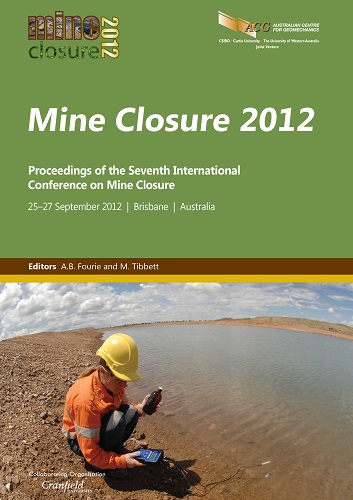Managing closure risks by integrating acid and metalliferous drainage assessments with mine scheduling – real world applications

|
Authors: Pearce, SR; Beavis, FR; Winchester, SJ; Thompson, H |
DOI https://doi.org/10.36487/ACG_rep/1208_66_Pearce
Cite As:
Pearce, SR, Beavis, FR, Winchester, SJ & Thompson, H 2012, 'Managing closure risks by integrating acid and metalliferous drainage assessments with mine scheduling – real world applications', in AB Fourie & M Tibbett (eds), Mine Closure 2012: Proceedings of the Seventh International Conference on Mine Closure, Australian Centre for Geomechanics, Perth, pp. 801-813, https://doi.org/10.36487/ACG_rep/1208_66_Pearce
Abstract:
Acid and metalliferous drainage (AMD) impacts may be a cause of significant long term environmental liabilities, as evidenced on many historic mine sites containing legacy AMD issues worldwide. These historical precedents have led to AMD being recognised as a key closure risk by industry and regulators, which in turn has driven progressive advances in geochemical assessment and management in recent times. Many AMD risks on a typical mine site are based on mineral waste management strategy and practice. By association, mine planning and scheduling may therefore have a significant bearing on the potential for AMD related closure liabilities. Despite this, the assessment of AMD risk is often packaged into the environmental approvals and management process, which is often not directly connected with the mine planning and scheduling process. Consequently, AMD assessments and management plans are frequently progressed by an approvals team that is often somewhat disconnected from the mine planning and scheduling team. Subsequently, AMD management measures may be conceived after the scheduling process has moved into a more advanced and less flexible phase. Sometimes, this may be the result of a lack of early co-ordination and/or budget leading to a lack of hard geochemical data with which to begin classifying potentially acid forming material. Using an integrated approach to managing closure risk can be achieved via a method of assessment utilising 3D geochemical block modelling that can operate concurrently with (or within) the mine planning and scheduling process from early in the mine planning process. A more integrated approach sees AMD assessment and management being advanced concurrently with resource modelling to optimise results and minimise risk. Three case studies are presented in this paper where an integrated approach was used for conceptual closure planning through the environmental approvals stage. A further case study is presented where an integrated approach was taken to develop a mine plan. The application of this approach has so far proven encouraging.
References:
Brundtland, G. (ed) (1987) Our common future: The world commission on environment and development, Oxford University Press, Oxford, England.
DITR (2007) Department of Industry Tourism and Resources, Managing acid and metalliferous drainage, leading practice sustainable development program for the mining industry, Canberra, Australia, 107 p.
Harries, J. (1997) Acid mine drainage in Australia: Its extent and potential future liability, Supervising Scientist Report 125, Supervising Scientist, Canberra, 94 p.
ICMM (2003) International Council on Mining and Metals, Sustainable Development Framework, Available at www.icmm.com.
INAP (2009) International Network for Acid Prevention, Global Acid Rock Drainage Guide (GARD), Available at: .
Mudder, T. (2004) Coming down hard on ARD, Mining Environmental Management, May 2004, p. 2.
Western Australian Department of Mines and Petroleum and the Western Australian Environmental Protection Authority (2011). Guidelines for preparing mine closure plans, Perth, 78 p.
© Copyright 2025, Australian Centre for Geomechanics (ACG), The University of Western Australia. All rights reserved.
View copyright/legal information
Please direct any queries or error reports to repository-acg@uwa.edu.au
View copyright/legal information
Please direct any queries or error reports to repository-acg@uwa.edu.au